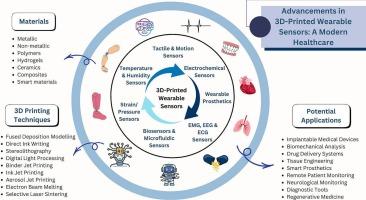Advancements in 3D-printed wearable sensors: a modern healthcare
IF 22
1区 材料科学
Q1 MATERIALS SCIENCE, MULTIDISCIPLINARY
引用次数: 0
Abstract
Modern healthcare has been transformed by introducing 3D-printed wearable sensors, providing rapid, inexpensive, and customised diagnostic alternatives. An overview of 3D-printed wearable sensors, their development history, and the evolution of 3D printing technology are explored in this study, offering a thorough analysis of the developments associated with wearable sensors for modern healthcare and biomedical applications. Different 3D printing techniques, such as stereolithography, inkjet printing, fused deposition modelling, and other 3D printing methods, are summarised. The materials used for these techniques, such as flexible substrates, biocompatible composites, and conductive polymers, are thoroughly reviewed simultaneously, focusing on their relevance to healthcare. This review comprehensively examines the materials and methodologies used in developing 3D-printed wearable sensors for healthcare and biomedical applications, emphasising their significance, potential applications, and key findings from recent research. The study analyses the significant challenges posed by material limitations, printing resolution, and biocompatibility while critically assessing the primary advantages of 3D-printed wearable sensors, such as personalisation, rapid prototyping, and scalability. Design considerations are also thoroughly evaluated to maximise sensor performance and reliability, emphasising flexibility, durability, and user comfort. The overview further describes various healthcare applications of these sensors, from real-time diagnostic tools and continuous vital sign monitoring to rehabilitation devices. This review aims to provide valuable insights for researchers, engineers, and healthcare professionals by combining recent advancements and identifying current limitations. The review also explores future directions, focusing on sustainable materials for environmentally friendly sensor development and the integration of AI and IoT technologies for improved monitoring and diagnostics.

3d打印可穿戴传感器的进步:现代医疗保健
通过引入3d打印可穿戴传感器,现代医疗保健已经发生了转变,提供了快速、廉价和定制的诊断替代方案。本研究概述了3D打印可穿戴传感器的发展历史,以及3D打印技术的发展,并对现代医疗保健和生物医学应用中可穿戴传感器的发展进行了全面分析。总结了不同的3D打印技术,如立体光刻、喷墨打印、熔融沉积建模和其他3D打印方法。用于这些技术的材料,如柔性基板、生物相容性复合材料和导电聚合物,将同时进行全面审查,重点关注它们与医疗保健的相关性。本综述全面考察了用于医疗保健和生物医学应用的3d打印可穿戴传感器开发的材料和方法,强调了它们的重要性、潜在应用和最近研究的主要发现。该研究分析了材料限制、打印分辨率和生物相容性带来的重大挑战,同时批判性地评估了3d打印可穿戴传感器的主要优势,如个性化、快速原型和可扩展性。设计考虑因素也经过全面评估,以最大限度地提高传感器的性能和可靠性,强调灵活性,耐用性和用户舒适度。概述进一步描述了这些传感器的各种医疗保健应用,从实时诊断工具和连续生命体征监测到康复设备。本综述旨在通过结合最近的进展和确定当前的局限性,为研究人员、工程师和医疗保健专业人员提供有价值的见解。该综述还探讨了未来的发展方向,重点关注环境友好型传感器开发的可持续材料以及人工智能和物联网技术的集成,以改进监测和诊断。
本文章由计算机程序翻译,如有差异,请以英文原文为准。
求助全文
约1分钟内获得全文
求助全文
来源期刊

Materials Today
工程技术-材料科学:综合
CiteScore
36.30
自引率
1.20%
发文量
237
审稿时长
23 days
期刊介绍:
Materials Today is the leading journal in the Materials Today family, focusing on the latest and most impactful work in the materials science community. With a reputation for excellence in news and reviews, the journal has now expanded its coverage to include original research and aims to be at the forefront of the field.
We welcome comprehensive articles, short communications, and review articles from established leaders in the rapidly evolving fields of materials science and related disciplines. We strive to provide authors with rigorous peer review, fast publication, and maximum exposure for their work. While we only accept the most significant manuscripts, our speedy evaluation process ensures that there are no unnecessary publication delays.
 求助内容:
求助内容: 应助结果提醒方式:
应助结果提醒方式:


